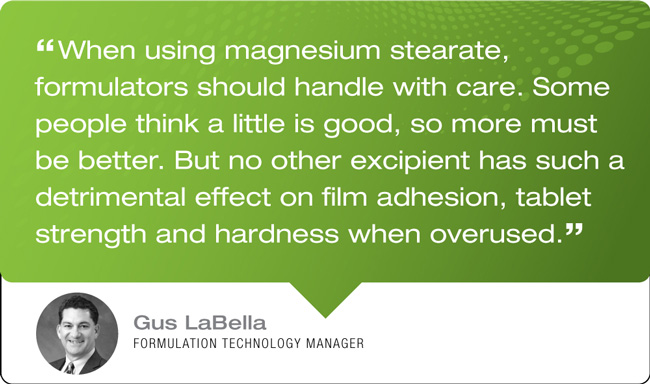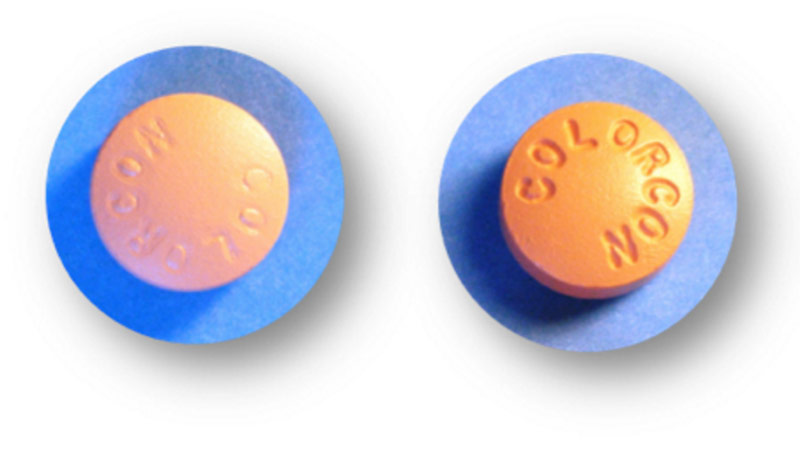Top Tips for Perfect Film Coating Adhesion
September 26, 2017
For formulators of any solid oral dosage form, the quality and characteristics of the active pharmaceutical ingredient (API) and excipients are of utmost importance. However, there are a multitude of additional factors that can affect the quality of the final product, including the tablet core substrate, coating formulation, and process. Making the right decisions about these factors early in the development cycle will help reduce the risk of future scale-up problems, product registration delays and downstream manufacturing issues.
Through experience, we’ve learned about ensuring effective coating adhesion from the beginning:
Tip 1: Consider core lubricants carefully
Lubricants are added to tablet formulations to minimize die-wall friction and punch adhesion. Both require that lubricants function at the tablet surface — precisely where they are counter-productive in the adhesion process, considering the inherent hydrophobic nature of lubricants, such as magnesium stearate. Excessive use makes the tablet softer, decreases film coating adhesion, and slows down disintegration and dissolution.
Selection of plastically deforming and/or self-lubricating excipients in the core formulation — such as Starch 1500®, partially pregelatinized maize starch — can greatly reduce the amount of lubricant needed for ease of tableting. Other lubricants, such as stearic acid, are also effective with less potentially damaging effects.

Tip 2: Don’t just grab any random coating off the shelf
All coatings are not created equal. Each ingredient in a film coating formulation can affect adhesion to the core. This is especially important when dealing with waxy or friable cores, or a tablet with a debossed logo. Recent advances in film coating technology (use of new polymers like polyvinyl alcohol [PVA] and PVA-PEG graft copolymer) have greatly improved film adhesion to the waxiest substrates, preventing defects such as peeling, logo bridging, and even edge chipping.
Careful consideration and selection of the film coating formulation can prevent these issues from the start.

Coatings are not one size fits all. We coated a waxy tablet with a traditional HPMC-based film coating (left) which shows obvious logo bridging because of poor adhesion. By using a PVA-based Opadry II film coating on the exact same core, the logo is crisp and clear (right) because of PVA’s excellent adhesion properties.
At Colorcon, we encourage you to connect with us early in your development process, so we can take the guesswork out of choosing the right coating for your tablet.
Tip 3: Design your logo for coating
In addition to coating formulation, consideration of the design and placement of the logo are crucial for successful coating application. Tablet tooling should be designed with coating in mind, and most tooling manufacturers already know what that means — gently angled, wider, and shallower as opposed to a sharp, narrow angle. With an optimal logo design, then the coating application process will result in sharp logo definition and readability.
Tip 4: Consider your options early
From much experience, we know that changing the core or coating formulation is often not an option at later stages of development. In such situations, minor process adjustments are the only changes possible. Process changes can sometimes resolve defects like logo bridging, but they don’t alleviate the inherent adhesion issues behind logo bridging.
For example, in the case of a poorly selected film coating onto waxy cores, the process can be changed to force decreased film strength to prevent logo bridging, but this results in a weaker, rougher finish and could still lead to occasional batch failure. While this is sometimes the only solution available, earlier consideration could have avoided development and production challenges down the road, which is why we encourage you to reach out and connect with a Colorcon expert early.
At Colorcon, our goal is to help our customers make every tablet a perfect tablet, every time. Perfect film coating is best achieved when we connect with you early and understand first-hand the challenges your formulation, coating and manufacturing process may present.
